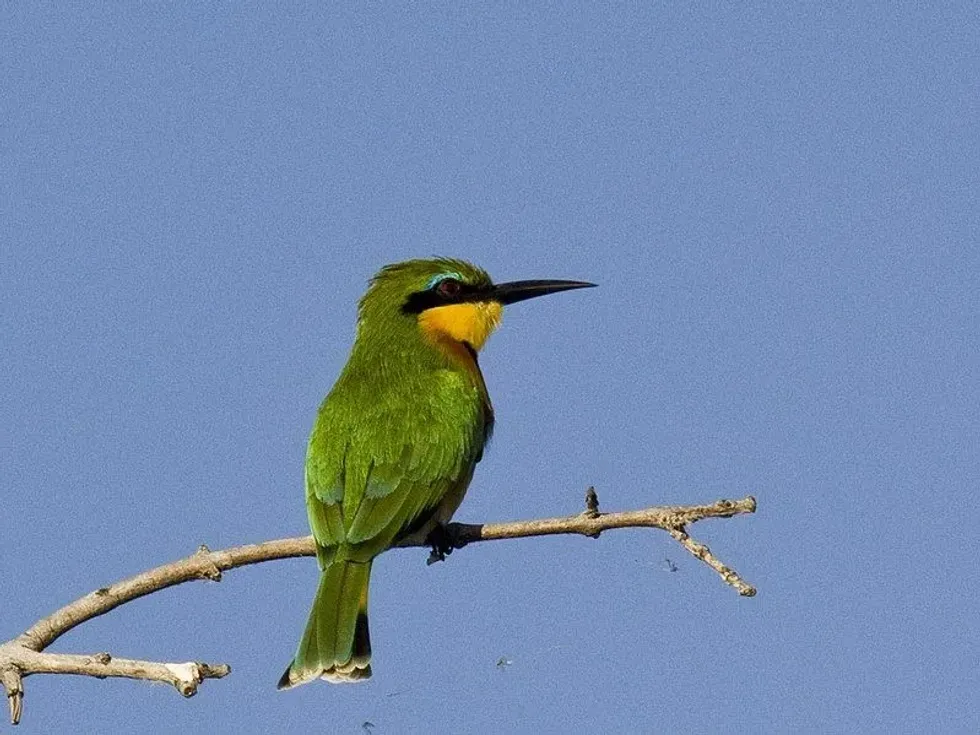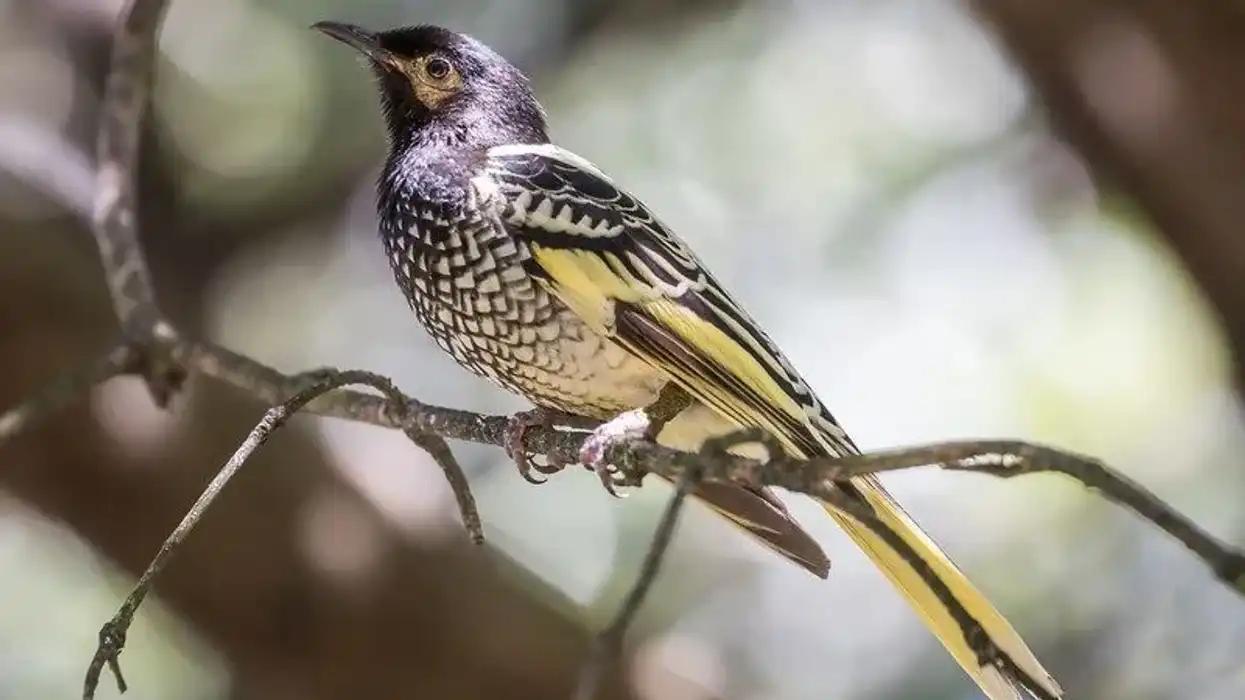The Little Bee-Eater is also known as Merops pusillus scientifically. This bird is found mostly in Africa and specifically Sub-Saharan Africa. This bee-eater eats flying insects like bees, wasps, crickets, and butterflies.
The little bee-eater habitat includes open areas with bushes and trees near water sources. They tend to be on low perches to prey or hunt on flying insects as these bee-eaters do not eat insects on the ground.
These bee-eaters like others have brightly colored plumage and slender bodies. They have a yellow throat and black gorgets and are green birds because of the upper parts. The breeding happens in pairs and the female lays around four to six white eggs.
Incubation takes 18-20 days. They are often confused with little green bee-eater.
The little bee-eater adaptations include the holes in the trees and low perches. Mostly, the common bee-eater is found in Africa. The little bee-eater bird is one fascinating creature to know about and if you like, read about the Hawaiian crow and macaroni penguin too.
Little Bee Eater Interesting Facts
What type of animal is a Little Bee Eater?
Little Bee Eaters are birds.
What class of animal does a Little Bee Eater belong to?
These bee-eaters belong to the class of Aves of birds.
How many Little Bee Eaters are there in the world?
The estimation states that there are around 60-80 million of this bee-eater.
Where does a Little Bee Eater live?
These birds live in woodlands and savannahs and are mostly found in Sub-Saharan Africa.
What is a Little Bee Eater's habitat?
The habitat of this bird is open habitats and areas with bushes and small trees, close to water sources. They hunt on prey found on low and bare branches.
Who do Little Bee Eaters live with?
This bird might be solitary and can also be found in small groups or roost communally.
How long does a Little Bee Eater live?
Little bee-eater lifespan ranges from 12-18 years.
How do they reproduce?
Unlike others, this species does not breed in large communities and forms pairs. In southern Africa, breeding takes place at the end of the dry season and the beginning of the rainy season, that is, September-November.
Nesting happens in burrows that are around 50-130 cm deep made in sandy lands or abandoned burrows of other animals. Four to six white eggs are laid and these eggs are round in shape. Incubation takes place for around 18-20 days by both males and females.
What is their conservation status?
The conservation status of this bird is Least Concern and they are not thought to be a species at risk.
Little Bee Eater Fun Facts
What do Little Bee Eaters look like?
These birds are bright-colored and slender. The upperparts are green, have a yellow throat, and have black gorgets. The upper breasts are rich brown in color which fades to ochre as it goes down to the belly. The beaks are black and the wings are green and brown. Both the sexes look alike.
How cute are they?
These birds are considered cute because of their beautiful and attractive appearance.
How do they communicate?
These bee-eaters are known to use calls to locate or communicate with their partners. It is believed that their calls are often silent and are a soft 'seep'.
How big is a Little Bee Eater?
The length of this bird is around 6-7 in (150-170 mm) and weighs up to 0.033 lb (0.015 kg).
How fast can a Little Bee Eater fly?
The exact speed of this bird is unknown but bee-eaters are known to be quite acrobatic and are good flyers.
How much does a Little Bee Eater weigh?
These species weigh around 0.033 lb (0.015 kg).
What are their male and female names of the species?
There are no specific names for males and females of the species.
What would you call a baby Little Bee Eater?
There is no particular name for a baby of this species but the babies of birds in general, are called chicks.
What do they eat?
The Little bee-eater diet primarily includes insects like bees, wasps, and hornets. The diet also includes bugs, beetles, termites, moths, and flies. They also eat butterflies, crickets, dragonflies, spiders, and caterpillars.
Are they dangerous?
There have been no harmful instances or incidence recorded yet and thus, this bird is not considered to be dangerous to humans.
Would they make a good pet?
It is believed that these birds make good pets just like other softbills. The diet should be live food and the housing should be taken care of as this is a tropical bird and thus, must be kept in heated enclosures in winters if you live in very cold areas.
This bird nests in earthen walls, so if you plan to keep this bird as a pet, a mud or an earthen wall should be constructed.
Did you know...
There are almost 27 species of bee-eaters. To look for them in their natural habitat, they are found in open grounds and low perches.
There happen seasonal movements among this species depending on the rainfall pattern.
This bird only catches or preys on flying insects and not on insects laying on the ground.
The stinger of the insects is removed by repeatedly hitting and rubbing the insect on a hard surface.
There is not much difference between males and females as both look alike but in some species, females have shorter streams and duller throats.
The Little Bee Eater's survival techniques
This bird makes holes in the trees as they require elevated perches for hunting. Also, the calls of this bird are like a soft seep that is used to locate partners and other communications.
Little Bee Eater vs Rainbow Bee Eater
Rainbow bee eaters' calls are high-pitched and have rapid vibrations whereas the call of the little bee-eater is soft. Little bee-eaters are solitary nesters while Rainbow bee-eater roosts in colonies.
Here at Kidadl, we have carefully created lots of interesting family-friendly animal facts for everyone to discover! Learn more about some other birds including the Marbled Murrelet, or the Black Necked Stilt.
You can even occupy yourself at home by drawing one on our Little bee eater coloring pages.










